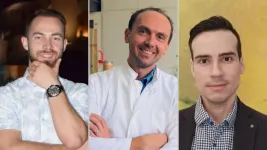Oral health needs among youth with a history of foster care
2021-06-08
(Press-News.org) According to estimates from the Children's Bureau, an agency within the U.S. Department of Health and Human Services, there were 673,000 children in or entering foster care in the United States in 2019.
Data from the Minnesota Department of Human Services say that approximately 15,300 children experienced foster care in 2019. Minnesotan children of color were overrepresented compared to the general population, with Native American children 18 times more likely and Black children three times more likely to experience foster care than white children.
Most children in the foster care system have medical and dental coverage through Medicaid. However, despite mandatory state dental coverage, children in foster care face significant barriers to accessing oral health care. One of the largest obstacles is finding a dental provider who takes Medicaid or the Children's Health Insurance Program.
A new study from the University of Minnesota published in The Journal of the American Dental Association compared the self-identified oral health needs and access to dental care among youth who have and have not experienced foster care. The data was drawn from the 2019 Minnesota Student Survey, a statewide survey of public-school students in grades 5th, 8th, 9th and 11th. Youth with a history of foster care were compared to youth with no history of foster care on seven oral health indicators.
Youth were asked whether or not they had experienced five types of dental problems in the past 12 months:
Toothaches or pain;
Decayed teeth or cavities;
Swollen, painful, or bleeding gums;
Could not eat certain foods because of a dental problem;
Missed one or more school days because of a dental problem.
If youth reported any dental problems, they were then asked if this dental health issue was treated by a dentist and when they last had an appointment at a dental office for a check-up, exam, teeth cleaning or other dental work. Finally, they were asked about routine dental care: when was the last time they saw a dentist for a check-up, exam, or teeth cleaning or other dental work.
"To our knowledge, this study is the first in the United States to survey youth with a history of foster care about their oral health care needs using their own words," said study co-author Elise W. Sarvas, a clinical associate professor in pediatric dentistry at the U of M School of Dentistry. "We found that compared to their peers, youth with a history of foster care have self-identified dental needs, including issues with pain, and they have less access to a dentist to address these needs."
Specifically, the study presented that:
Youth with a history of foster care were more likely to report each of the five dental problems and less likely to report receiving dental care, compared to their peers with no history of foster care;
Approximately 44% of youth with a history of foster care reported at least one dental problem, compared to 32.2% of youth with no experience of foster care;
Youth with a history of foster care had lower odds of seeing a dentist for a dental problem (58.2% vs. 71.2%) or for routine dental care (69.6% vs. 84.4%), than their peers with no history of foster care.
"There are likely a number of reasons why youth with a history of foster care have more dental problems relative to their peers," said co-author Rebecca J. Shlafer, an assistant professor in the U of M Medical School. "Compared to their peers, foster youth in this sample were more likely to report living in households experiencing poverty. "Dentists should recognize the oral health concerns of this group of kids in the context of their special health care needs and be prepared to render appropriate care."
INFORMATION:
Co-authors include Judith K. Eckerle and Kimara L. Gustafson with the Medical School and Rebecca L. Freese with the Clinical and Translational Science Institute in the Office of Academic Clinical Affairs.
Support for this study was provided by the National Institutes of Health's National Center for Advancing Translational Sciences, the Centers for Disease Control and Prevention and the Health Resources and Services Administration.
ELSE PRESS RELEASES FROM THIS DATE:
2021-06-08
MELVILLE, N.Y., June 8, 2021 -- The COVID-19 pandemic created numerous changes and challenges for many people. In the education field, teachers were asked to re-create lesson plans and student interactivity in a virtual realm, something many had never experienced.
During the 180th Meeting of the Acoustical Society of America, which will be held virtually June 8-10, Andrew Morrison, from Joliet Junior College, will reveal lessons learned by educators during remote teaching caused by the pandemic and what techniques they can use in the return to classroom instruction. The session, "Lessons learned teaching through a pandemic and looking forward to a post-COVID-19 classroom," will take place Tuesday, June 8, at 1:45 p.m. Eastern U.S.
Morrison ...
2021-06-08
MELVILLE, N.Y., June 8, 2021 -- Due to strict lockdown measures around the globe during the coronavirus pandemic, many of us have seen and heard our family members and neighbors much more than ever before. Accordingly, many of us have been more annoyed by the sounds of our household than ever before.
During the 180th Meeting of the Acoustical Society of America, which will be held virtually June 8-10, Ayca Sentop Dümen and Konca Saher, from the Turkish Acoustical Society, will discuss the effects of pandemic-related noise on people's satisfaction with their homes and how this information can help inform future design choices. Their presentation, "Noise annoyance in dwellings during the first wave of Covid-19," will take place Tuesday, June ...
2021-06-08
ROCKVILLE, MD, USA - June 8, 2021 - The PfSPZ malaria vaccines of Sanaria Inc. are unique in vaccine development as they are composed of weakened (attenuated) forms of the live parasite cells that cause malaria. These parasite cells are called eukaryotic cells and there are no vaccines against any infectious disease composed of such cells. Furthermore, there are no licensed vaccines against any infectious disease caused by a eukaryotic pathogen. Thus, Sanaria and its collaborators have had to take a step by step empirical approach to optimizing immunization with PfSPZ vaccines to achieve a safe, effective, durable, and broadly protective malaria vaccine.
Two recent landmark malaria vaccine studies ...
2021-06-08
Financing a sustainable global ocean economy may require a Paris Agreement type effort, according to a new report from an international team of researchers led by the University of British Columbia.
That's because a significant increase in sustainable ocean finance will be required to ensure a sustainable ocean economy that benefits society and businesses in both developing and developed countries.
The report, published today - on World Ocean Day - identifies major barriers to financing such a sustainable ocean economy. This includes all ocean-based industries, like seafood production, shipping and renewable energy, and ecosystem goods and services, ...
2021-06-08
Monarch butterflies raised indoors still know how to fly south if given enough time to orient themselves, according to new University of Guelph research.
The finding is good news for the many nature lovers and school students who raise monarchs and then set them free to help boost struggling numbers.
Monarchs are the only butterfly known to make a long-distance migration to warmer wintering grounds. While those born in the spring and early summer live only from two to six weeks, those that emerge in the late summer sense environmental signals that tell them to fly thousands of kilometres south, to central Mexico.
Recent ...
2021-06-08
Ever since the world's first ever microscope was invented in 1590 by Hans and Zacharias Janssen --a Dutch father and son-- our curiosity for what goes on at the tiniest scales has led to development of increasingly powerful devices. Fast forward to 2021, we not only have optical microscopy methods that allow us to see tiny particles in higher resolution than ever before, we also have non-optical techniques, such as scanning force microscopes, with which researchers can construct detailed maps of a range of physical and chemical properties. IBEC's Nanoscale bioelectrical characterization group, led by UB Professor Gabriel Gomila, in collaboration with members of the IBEC's Nanoscopy for nanomedicine group, have been ...
2021-06-08
Age-related macular degeneration (AMD) is the most common cause of vision loss in people over 50. Up to 12 percent of those over 80 have the chronic disease. An estimated 16.4 million adults are affected by retinal vein occlusion (RVO) worldwide, a condition caused by a thrombosis of a retinal vein. It is the second most common cause of blindness from retinal vascular disease after diabetic retinopathy (DR). DR in turn is the leading cause of blindness in developed countries and affects up to 80 percent of people with more than 20 years of diabetes. It can lead ...
2021-06-08
A defining characteristic of all life is its ability to evolve. However, the fact that biologically engineered systems will evolve when used has, to date, mostly been ignored. This has resulted in biotechnologies with a limited functional shelf-life that fail to make use of the powerful evolutionary capabilities inherent to all biology.
Sim Castle, first author of the research, published in Nature Communications, and a PhD student in the School of Biological Sciences at Bristol, explained the motivation for the work: "The thing that has always fascinated me about biology is that it changes, it is chaotic, it adapts, it evolves. Bioengineers therefore do not just design static artefacts - they design living populations that ...
2021-06-08
The presence of amino acids on the prebiotic Earth is widely accepted, either coming from endogenous chemical processes or being delivered by extraterrestrial material. On the other hand, plausibly prebiotic pathways to peptides often rely on different aqueous approaches where condensation of amino acids is thermodynamically unfavorable. Now, chemists from the Ruđer Bošković Institute (RBI), in collaboration with colleagues from Xellia Pharmaceuticals, have shown that solid-state mechanochemical activation of glycine and alanine in combination with mineral surfaces leads to the formation of peptides. ...
2021-06-08
A team of astronomers using the Atacama Large Millimeter/submillimeter Array (ALMA) has completed the first census of molecular clouds in the nearby Universe, revealing that contrary to previous scientific opinion, these stellar nurseries do not all look and act the same. In fact, they're as diverse as the people, homes, neighborhoods, and regions that make up our own world.
Stars are formed out of clouds of dust and gas called molecular clouds, or stellar nurseries. Each stellar nursery in the Universe can form thousands or even tens of thousands of new stars during its lifetime. Between 2013 and 2019, astronomers on the PHANGS-- Physics at High Angular Resolution in Nearby GalaxieS-- project conducted the first systematic survey of 100,000 stellar nurseries ...
LAST 30 PRESS RELEASES:
[Press-News.org] Oral health needs among youth with a history of foster care








